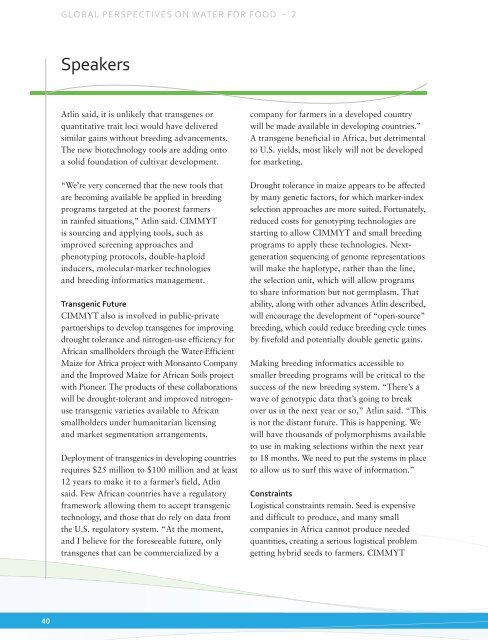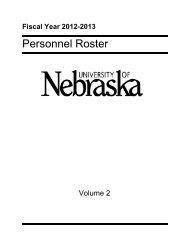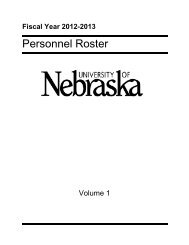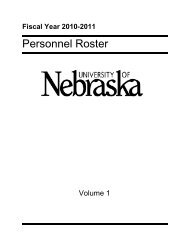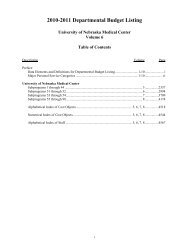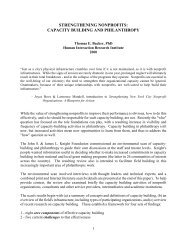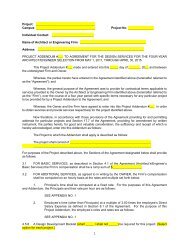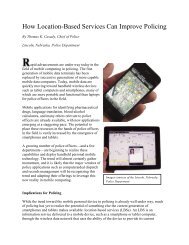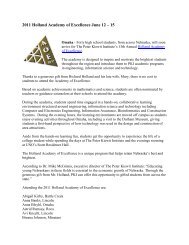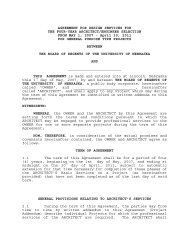Full Version - Water for Food Institute - University of Nebraska
Full Version - Water for Food Institute - University of Nebraska
Full Version - Water for Food Institute - University of Nebraska
You also want an ePaper? Increase the reach of your titles
YUMPU automatically turns print PDFs into web optimized ePapers that Google loves.
40<br />
GLOBAL PERSPECTIVES ON WATER FOR FOOD 2<br />
Speakers<br />
Atlin said, it is unlikely that transgenes or<br />
quantitative trait loci would have delivered<br />
similar gains without breeding advancements.<br />
The new biotechnology tools are adding onto<br />
a solid foundation <strong>of</strong> cultivar development.<br />
“We’re very concerned that the new tools that<br />
are becoming available be applied in breeding<br />
programs targeted at the poorest farmers<br />
in rainfed situations,” Atlin said. CIMMYT<br />
is sourcing and applying tools, such as<br />
improved screening approaches and<br />
phenotyping protocols, double-haploid<br />
inducers, molecular-marker technologies<br />
and breeding in<strong>for</strong>matics management.<br />
Transgenic Future<br />
CIMMYT also is involved in public-private<br />
partnerships to develop transgenes <strong>for</strong> improving<br />
drought tolerance and nitrogen-use efficiency <strong>for</strong><br />
African smallholders through the <strong>Water</strong>-Efficient<br />
Maize <strong>for</strong> Africa project with Monsanto Company<br />
and the Improved Maize <strong>for</strong> African Soils project<br />
with Pioneer. The products <strong>of</strong> these collaborations<br />
will be drought-tolerant and improved nitrogenuse<br />
transgenic varieties available to African<br />
smallholders under humanitarian licensing<br />
and market segmentation arrangements.<br />
Deployment <strong>of</strong> transgenics in developing countries<br />
requires $25 million to $100 million and at least<br />
12 years to make it to a farmer’s field, Atlin<br />
said. Few African countries have a regulatory<br />
framework allowing them to accept transgenic<br />
technology, and those that do rely on data from<br />
the U.S. regulatory system. “At the moment,<br />
and I believe <strong>for</strong> the <strong>for</strong>eseeable future, only<br />
transgenes that can be commercialized by a<br />
company <strong>for</strong> farmers in a developed country<br />
will be made available in developing countries.”<br />
A transgene beneficial in Africa, but detrimental<br />
to U.S. yields, most likely will not be developed<br />
<strong>for</strong> marketing.<br />
Drought tolerance in maize appears to be affected<br />
by many genetic factors, <strong>for</strong> which marker-index<br />
selection approaches are more suited. Fortunately,<br />
reduced costs <strong>for</strong> genotyping technologies are<br />
starting to allow CIMMYT and small breeding<br />
programs to apply these technologies. Nextgeneration<br />
sequencing <strong>of</strong> genome representations<br />
will make the haplotype, rather than the line,<br />
the selection unit, which will allow programs<br />
to share in<strong>for</strong>mation but not germplasm. That<br />
ability, along with other advances Atlin described,<br />
will encourage the development <strong>of</strong> “open-source”<br />
breeding, which could reduce breeding cycle times<br />
by fivefold and potentially double genetic gains.<br />
Making breeding in<strong>for</strong>matics accessible to<br />
smaller breeding programs will be critical to the<br />
success <strong>of</strong> the new breeding system. “There’s a<br />
wave <strong>of</strong> genotypic data that’s going to break<br />
over us in the next year or so,” Atlin said. “This<br />
is not the distant future. This is happening. We<br />
will have thousands <strong>of</strong> polymorphisms available<br />
to use in making selections within the next year<br />
to 18 months. We need to put the systems in place<br />
to allow us to surf this wave <strong>of</strong> in<strong>for</strong>mation.”<br />
Constraints<br />
Logistical constraints remain. Seed is expensive<br />
and difficult to produce, and many small<br />
companies in Africa cannot produce needed<br />
quantities, creating a serious logistical problem<br />
getting hybrid seeds to farmers. CIMMYT


